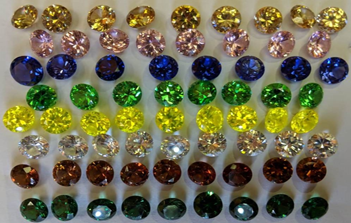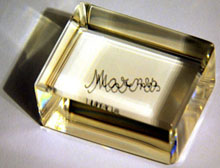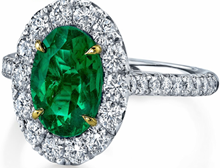Lab-grown YAG (Yttrium Aluminium Garnet)
LifeGem Diamonds Limited is pleased to introduce cut & polished gemstones made from the second generation mono-crystal optic YAG (Yttrium Aluminium Garnet), sourced from Europe.
YAG is a much better simulant for diamond and for precious stones, due to its high hardness and transparency. It has a strong dispersion with brilliant diamond-like shining. YAG has the cubic structure of natural garnet.
YAG - a lab-grown semi-precious gemstone -
Yttrium aluminum garnets (YAG) are the structural analogues of expensive natural garnets, but excel them in hardness, transparency and dimension of flawless zone. They cut and polish like natural garnets and are very pretty.
The mechanical and chemical stability of YAG is similar to that of sapphire. YAG is not birefringent and this particular feature is important for natural appearance.
YAG is stable and resistant to acids and alkalis, as well as UV rays, hot water, perfumes, etc. Due to its high hardness, it is scratch-proof and meant for daily wear. Its faceted surface does not chip out during rough use. YAG’s useful life is 50-100 years.
YAG in different colours | |
 |  |
YAG – a diamond simulant:
Due to strong dispersion, YAG crystals create a diamond play-of-color. They are colorless when grown without additives, but doping with rare earth elements is enough to give them a wide spectrum of colors, including vibrant hues.
For instance, when doped with neodymium or erbium, they get pink or purple shades; and when doped with cerium, they get yellow shades.
YAG has a great clarity, brilliance, luster and sparkle; it is flawless with no visible inclusions, blemishes or scratches. It has a bright luster approaching that of a diamond (sub-adamantine luster). Due to its high hardness, YAG takes excellent polish, displays some fire and is regarded as a man-made diamond simulant.
YAG is also a perfect simulant for precious gemstones like Emerald, Ruby, Sapphire and Alexandrite.
Parameters |
Cubic zirconia* |
European YAG |
Diamond |
Emerald |
Ruby & Sapphire |
Colour-changing Alexandrite |
Description |
Artificial, obtained on a large-scale by skull melting process, prone to abrasion and scratches |
Lab-grown semi-precious stone, highly resistant to abrasion and scratches |
Mined or lab-grown, precious, abrasion-proof and scratch-proof |
Precious stone |
Precious stones |
Precious stone |
Mineral |
Zirconium oxide |
Yttrium Aluminium Garnet |
Carbon |
Beryl |
Corundum |
Chrysoberyl |
Chemical formula |
ZrO2 +10-35%Y2O3 |
Y3Al5O12 |
C |
Be3Al2(SiO3)6 |
Al2O3:Cr |
BeАl2О4:Cr3+ |
Moh’s hardness |
7.5-8.0 |
8.5 |
10.0 |
8.0 |
9.0 |
8.5 |
Absolute hardness |
150-200 |
300 |
1,600 |
200 |
400 |
300 |
Specific gravity (density in grams / cm3) |
6.0 |
4.55 |
3.52 |
2.63 – 2.75 |
3.97-4.05 |
3.73 |
Dispersion |
0.060 |
0.028 |
0.044 |
0.014 |
0.018 |
0.015 |
Refractive index (sparkle or brilliance) |
2.09-2.18 |
1.83 |
2.42 |
1.56-1.60 |
1.76-1.78 |
1.75-1.76 |
Heat resistance (when wax casting with metals at 800°C / above) |
No |
Yes |
No |
No |
Yes |
Yes |
Birefringence** |
0.430-0.500 |
Absent |
Absent |
0.004-0.007 |
0.008 |
0.008-0.01 |
* Cubic Zirconia (CZ) is the most popular material for simulated gem stones, as it has high refractive index, good hardness & wide colour scale. It is also cheap. But, over the years, CZ became ‘boring’ to the customers. More and more people now consider it to be bad for its unnatural gloss (as Europeans say it ‘impudently shines’). Now-a-days, CZ is regarded as a costume gemstone, meant for single use.
** Birefringence or double refraction is based on the difference between high and low refractive indexes in gemstones. Diamond is well-known as singly refractive, and very few gemstones including YAG have this property. Gemstones with high birefringence display two or three colours, depending on the viewing angle. They have the effects of fuzzy, out-of-focus appearance, creating a blurred double vision effect (if the stone is faceted, the facets on the opposite side of the viewer will appear to be doubled). Most plastics also have birefringence effects.
Images showing birefringence in cubic zirconia | |
 |  |
For jewellery applications, we offer cut & polished YAG in 10 colours and shades, in the size range from 3 mm to 15 mm (0.15 carat to 20 carats). The available colours are –